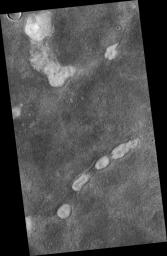
|
Proposed Future Mars Landing Site: Acidalia Planitia Mud Volcanoes
- Click the image above for a larger view
- Full-Res JPEG (2048 x 3145) (1.6 MB)
- Full-Res TIFF (2048 x 3145) (6.4 MB)
Caption:
This proposed future Mars landing site in Acidalia Planitia targets densely occurring mounds thought to be mud volcanoes.
Mud volcanoes are geological structures formed when a mixture of gas, liquid and fine-grained rock (or mud) is forced to the surface from several meters to kilometers (several yards to miles) underground. Scientists are targeting these mud volcanoes because the sediments brought from depth could contain organic materials that might provide evidence about possible past and present microbial life on Mars.
This image covers an area about 6 kilometers (4 miles) wide. It is one product from an Oct. 2, 2010, HiRISE observation catalogued as ESP_019612_2250, of an area centered at 44.5 degrees north latitude, 317.2 degrees east longitude. Other image products from this observation are available at http://hirise.lpl.arizona.edu/ESP_019612_2250 .
Background Info:
NASA's Jet Propulsion Laboratory, a division of the California Institute of Technology in Pasadena, manages the Mars Reconnaissance Orbiter for NASA's Science Mission Directorate, Washington. Lockheed Martin Space Systems, Denver, built the spacecraft. The High Resolution Imaging Science Experiment is operated by the University of Arizona, Tucson, and the instrument was built by Ball Aerospace & Technologies Corp., Boulder, Colo.
Cataloging Keywords:
| Name | Value | Additional Values |
|---|---|---|
| Target | Mars | |
| System | ||
| Target Type | Planet | |
| Mission | Mars Reconnaissance Orbiter (MRO) | |
| Instrument Host | Mars Reconnaissance Orbiter | |
| Host Type | Orbiter | |
| Instrument | High Resolution Imaging Science Experiment (HiRISE) | |
| Detector | ||
| Extra Keywords | Grayscale, Volcano | |
| Acquisition Date | ||
| Release Date | 2010-12-01 | |
| Date in Caption | 2010-10-02 | |
| Image Credit | NASA/JPL-Caltech/University of Arizona | |
| Source | photojournal.jpl.nasa.gov/catalog/PIA13652 | |
| Identifier | PIA13652 | |
